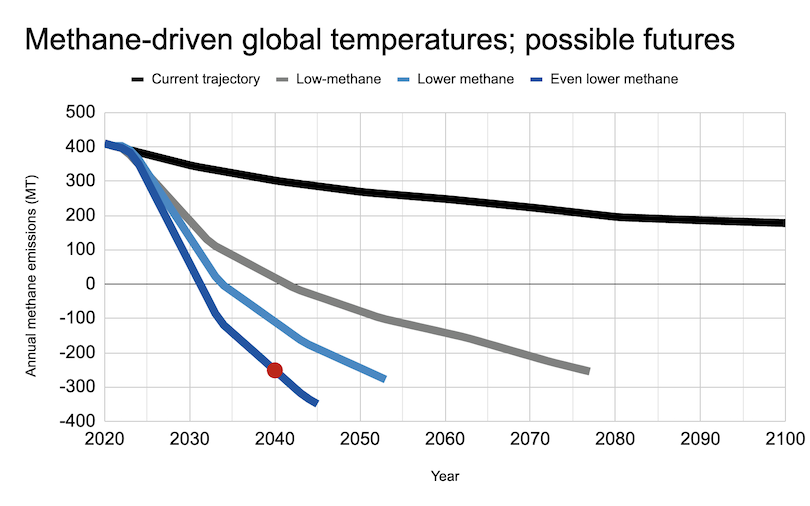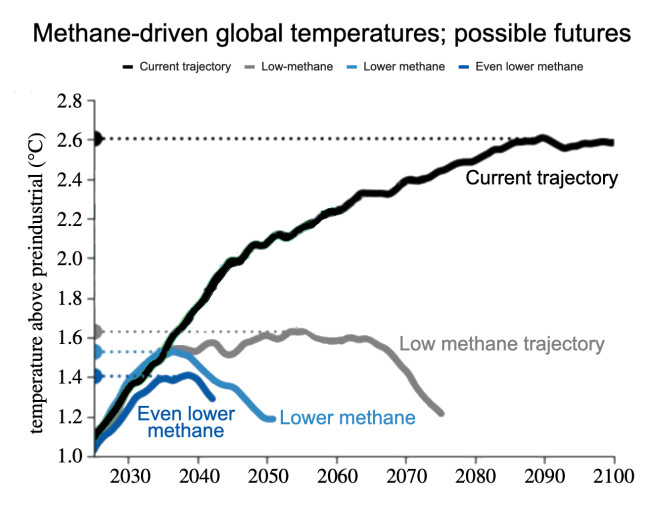Pull the "undo methane" lever

Author’s note: Throughout this article I’ve used rounded numbers; they’re easy to grok. Precise numbers are in the reference materials.
Summary#
If we remove 400 MT (megatons) of methane from our atmosphere every year by 2040, we can hope to shave ~1ºC off peak global warming. This would be a very big deal; no other comparatively safe approach that I’m aware of gets anywhere near this level of impact.
CO2 is not enough#
For the past two years I’ve been studying climate change: where we are headed, what’s happening, what’s not happening. The good news is that humanity is now collectively focused on climate change, with growing capital, talent, and policy joining forces to pull in the same direction.
The bad news is: it’s not enough. To keep our world safe and mostly stable, we must not let it warm more than 1.5ºC (above pre-industrial levels)—warmer temperatures would mean accelerated unraveling of systems. But we’re already at 1.2ºC, and according to the U.N. there is no credible pathway in place to hit the 1.5ºC goal1. In fact, even with all the progress we’ve made, it seems we are on track for a calamitous 2.6ºC of warming.
So far, most climate-change efforts have been rightly directed at reducing—and eventually eliminating—the carbon dioxide (CO2) we put into the air. Had we gotten serious about climate change 20, or even 10, years ago, just combating CO2 alone might have been enough. Unfortunately we didn’t, so in addition to reducing CO2, we need to pull another lever, too.
Methane to the rescue#
 Glory be, there is something else we humans have been doing that is dramatically heating the world: releasing methane. In fact, methane is responsible for more than 1/3rd of our current warming. Yes, really2. Perhaps counter-intuitively, this is wonderful news. It may be much more efficient to reduce methane in the atmosphere than CO2. And if we do it fast enough, we might yet avoid the worst.
Glory be, there is something else we humans have been doing that is dramatically heating the world: releasing methane. In fact, methane is responsible for more than 1/3rd of our current warming. Yes, really2. Perhaps counter-intuitively, this is wonderful news. It may be much more efficient to reduce methane in the atmosphere than CO2. And if we do it fast enough, we might yet avoid the worst.
Removal is neglected#
There are two ways to undo our methane: stop emitting, and start removing. Both are needed, as I’ll discuss below. But since it is much easier to not emit than to remove, almost all methane-reduction efforts are focused on emissions—the lowest-hanging fruit—which is the right place to start. To that end there are satellites in space that are looking for methane leaks on earth, and several companies saving money for their customers by detecting and stopping methane leaks and seepage.
That work is crucial, but that’s not what this article is primarily about. This article focuses on the also-crucial, mostly overlooked, high-hanging fruit of atmospheric methane removal—destroying methane that’s already in the air. It’s an area that is significantly under-invested, which means there is huge opportunity.
How big could this “undo” lever be?#
Right now the atmosphere has 5,300 MT of methane in it. (MT means megatons, or millions of tons.) For all of human history until about 1900, there was 2,100 MT of methane in the air. After that, we humans caused the other 3,200 MT. And as stated earlier, those 3,200 MT are what is causing 1/3rd of current warming.
Every year, humans emit another 400 MT and nature releases 200 MT3,4. As time passes methane oxidizes, becomes something else, and mostly stops causing warming. But oxidation doesn’t happen quickly enough, so airborne methane continues to increase.
Methane-driven future cooling#
Let’s define and chart a few possible future methane emissions scenarios. The scenarios below represent net human-caused emissions, meaning emissions minus any removals. They all start at today’s 400 MT and then diverge. They range from the black, current-business-as-usual methane emissions trajectory which never drops much below 200 MT, to the dark blue, exceptionally ambitious reduction trajectory which hits zero (meaning net-zero methane emissions) in 2032, and -250 MT in 2040.
 Data from “Methane removal and the proportional reductions in surface temperature and ozone”
S. Abernethy et. al, graph by author
Data from “Methane removal and the proportional reductions in surface temperature and ozone”
S. Abernethy et. al, graph by author
The graph below shows just how much each of these net methane emission scenarios (above) would affect global temperatures5. Again, the black line shows our current optimistic warming trajectory—2.6ºC above pre-industrial levels in about 70 years1. While 2.6ºC would be disastrous, it would be much hotter and worse if not for the excellent work on carbon dioxide reduction that’s been done so far, and we must continue at full speed. Note that in order to simplify the figure below, I’ve assumed an optimistic CO2 emission scenario.
 Simplified figure from “Methane removal and the proportional reductions in surface temperature and ozone”
S. Abernethy et. al
Simplified figure from “Methane removal and the proportional reductions in surface temperature and ozone”
S. Abernethy et. al
Whether our ultimate peak temperature is 1.4ºC or 1.5ºC… or 2.6ºC really matters. Once we hit certain temperatures, some parts of our ecosystem will change forever or die. Reducing global temperatures back to current levels in the future will not restore our world any more than putting out a house fire will restore a home.
Restoration targets#
To reach our best future—the dark blue line—we must both continue carbon dioxide reductions at full speed, and immediately begin reducing atmospheric methane levels. One way to read the dark blue line on the topmost graph is: to hit -250 MT/year by 2040 we need to have zero methane emissions and also remove another 250 MT. But as I’ll describe below, I’m pessimistic that we’ll reduce emissions to zero. I think we may succeed in getting our emissions down to 150 MT/year, which will leave us with another 400 MT to remove from the atmosphere.
We won’t stop emitting methane#
Just like it’s much easier to not add cream to your coffee than it is to remove cream from your coffee, isn’t it much easier to stop emitting methane than to remove it?
For some methane it is! For example some methane emission reductions cost nothing, or even generate revenue (such as methane capture from waste prior to venting it to the atmosphere). Some methane reduction strategies are expensive but we know how to do them. And some reductions we simply don’t know how to do; it’s unclear if we will discover them soon enough. The following diagram provides details6 but the summary is: with current technology we could mitigate 100 MT/year of emissions (24%) by 2030 for free or at a profit(!), and if we pulled out all the stops and spent heavily, we could eliminate another 150 MT/year (33%). So with current technology, this best-case scenario means a 250 MT/year reduction.
 Figure from “Acting rapidly to deploy readily available methane mitigation measures by sector can immediately slow global warming” Ilissa B Ocko et. al
Figure from “Acting rapidly to deploy readily available methane mitigation measures by sector can immediately slow global warming” Ilissa B Ocko et. al
Removal is necessary#
2030#
Let’s imagine that we are completely successful with current technologies, spend heavily, and reduce methane emissions by 250 MT/year by 2030, seven years from now. In that case, we’d still be emitting 150 MT. But for us to be on the dark-blue line (above), human-caused methane must be only 50 MT that year. That difference of 100 MT (50 MT instead of 150 MT) could be achieved either via additional emission reductions or atmospheric removal.
How plausible are additional emission reductions that would rely on advances in technology? I’m not sure, but we absolutely should pursue this technology as fast as we possibly can—especially for livestock and rice—over the next seven years. But deployment of that hypothetical technology will need to be distributed worldwide, farm by farm; this implies to me a slow roll-out. Therefore, since the time is short, the technology doesn’t exist, and deployment will be slow once it does exist, I believe we should not count on additional emission reductions and should be prepared to remove 100 MT of methane from the atmosphere by 2030. In fact, we should be prepared to remove even more if we aren’t completely successful deploying currently known emission reductions.
2040#
Looking ahead another decade to 2040, let’s imagine that humanity is 100% successful with methane and we’ve eliminated all human-caused methane emissions. In that case we would still need to remove 250 MT of methane from the atmosphere each year to stay on the dark-blue target line to achieve -250 MT net emissions.
And though 250 MT of removal is a tall order, I frankly don’t think it’s enough. I believe that some methane emissions will be too difficult and costly to hunt down, or we may not have solutions for them. Besides that, it turns out that as our climate warms, nature releases methane more quickly,7 so we will have even more methane to offset.
Rather than bet our future on an absolute best-case scenario where human-caused emissions will be zero in 2040, I’d rather bet on excellent, but not perfect, performance and assume humans still cause 150 MT of emissions. This would be equivalent to 100% rollout of all of today’s known methane reduction technologies, plus somewhat more due to 15% human population growth and increased natural methane emissions. I doubt that 150 MT is precisely right, but it’s a reasonable guess. Using this assumption:
150 MT emitted minus 400 MT removed = -250 MT net
Therefore we need to remove 400 MT of methane per year by 2040.
Avoid tipping#
 By the way, if we develop our ability to remove methane from the air, we will be prepared to mitigate at least some of the impact of a possible ecological tipping point: permafrost thaw. Should permafrosts thaw, during decomposition they will release high levels of methane into the atmosphere, raising global temperatures rapidly. Current scientific consensus indicates that permafrost thaw alone could perhaps increase temperatures by 0.5ºC by 2100, 8. That said, the scientific modeling is ongoing—for example how those frozen stores will decompose when thawed—exactly what percent will decompose into carbon dioxide vs methane? Future temperature projections will be very sensitive to this ratio.
By the way, if we develop our ability to remove methane from the air, we will be prepared to mitigate at least some of the impact of a possible ecological tipping point: permafrost thaw. Should permafrosts thaw, during decomposition they will release high levels of methane into the atmosphere, raising global temperatures rapidly. Current scientific consensus indicates that permafrost thaw alone could perhaps increase temperatures by 0.5ºC by 2100, 8. That said, the scientific modeling is ongoing—for example how those frozen stores will decompose when thawed—exactly what percent will decompose into carbon dioxide vs methane? Future temperature projections will be very sensitive to this ratio.
An aside about CO2 removal#
Lots of work and billions of dollars of funding have been committed to removing carbon dioxide from the atmosphere9,10. That’s because it’s one of the ways we could keep our peak temperature below 2.6ºC… if we execute exceptionally well. But the scale of action required is staggering. Each 1,000 MT of CO2 removed will reduce temperatures by just 0.0005ºC11,12. Doing this one thousand times over—removing 1,000,000 MT (one trillion tons, or about 2 quadrillion pounds)—would reduce global temperatures by 0.5ºC. Meanwhile, it seems that as of October 2022, 1/200th of one MT is the largest removal of all time. In other words, to reduce global temperatures by half a degree, we would need to remove 200 million times more CO2 than the largest removal to date.
Nonetheless, CO2 will make a difference, and we should absolutely keep pushing hard on CO2 removal. I am supporting several companies working in this space, such as Vesta and Tau. But in addition to the mind-boggling scale required, many carbon removal strategies are also challenging for other reasons: many require significant energy, which for now often means burning fossil fuels, and also the fact that CO2 is a very stable molecule, so you have to put it somewhere, monitor it and hope it stays there, and try to study the environmental effects very closely to not create unintended consequences.
Interestingly, CO2 emissions cause their entire lifetime’s worth of atmospheric warming very quickly—in about 10 years. This is surprising because CO2 hangs around in the atmosphere reflecting additional heat for hundreds of years. In its later years, the additional heat warms the ocean (not the atmosphere) and melts sea ice.13 All these warming effects will be highly dangerous in the coming decades and shouldn’t be discounted, but this article focuses on the emergency at hand—the atmospheric peak temperature which hopefully we will reach within 10–20 years.
Methane removal#
All this brings us to why atmospheric methane removal would be so powerfully effective. If we removed 1,000 MT of methane from the atmosphere today, it would reduce global temperatures by 0.1ºC 10 years from now5.
Contrast this with the 0.0005ºC effect of removing 1,000 MT of CO2 mentioned above and we see that, pound for pound, atmospheric methane removal is 200 times more effective for cooling the atmosphere than CO2 over a ten year timeframe. To be clear, over much longer periods of time, the effect of current methane removal would drop to zero because it would have naturally degraded anyway. For example, after 20 years, methane removal would only have 100 times the effect of CO2 removal, and would continue to drop from there.
But for limiting peak atmospheric temperatures over the next decades, I don’t believe there is anything more promising than methane removal.
No storage#
Another advantage of removing methane from the air is that, unlike CO2, which is a very stable molecule, methane does not need to be captured, transported, or stored. Instead it can be destroyed (oxidized into CO2) on the spot. Of course, the CO2 could then be captured, but even if it were not captured, oxidizing methane reduces its warming effect by about 200x over the following 10 years, as described above.
Under-invested#
Despite the huge impact that methane removal would have, very little work is happening in this area. There are a handful of 7-figure projects highlighted at methaneaction.org. Taken together they are seeking, but don’t have, even 1/1,000th of the funding provided to carbon dioxide removal. The space is massively under-invested relative to its potential for impact.
Challenging#
Though we may be removing “only” 400 MT/year, this is quite large by human standards. 400 MT is almost a trillion pounds! To make matters more difficult, methane is quite diffuse at only 2 parts per million.
Strategies#
Some research has been done on methane removal, but there is still a lot to discover. Spark Climate has provided an excellent overview of plausible pathways. Five are briefly summarized below.
Hydrogen peroxide#
The idea here is to supercharge the largest natural methane removal pathway. Right now, hydroxyl radicals in the atmosphere are responsible for oxidizing ~500 MT of methane per year. This approach proposes to disperse low concentrations of hydrogen peroxide vapor in the troposphere. UV light from the sun will react with the hydrogen peroxide and form additional hydroxyl radicals. If implemented, this approach may also have secondary air-quality benefits such as reducing carbon monoxide and VOCs.
Iron-salt aerosols#
This pathway also relies on dispersing aerosols, in this case spraying iron salts into the air. It is hypothesized that this strategy will cool the planet via several mechanisms, one of which is the creation of atmospheric chlorine radicals. Chlorine radicals currently account for 3% of natural atmospheric methane oxidation. To date, only hypotheticals have been studied14; more study, and eventually real-world experimentation, is needed to determine effects on humans and the ecosystem.
Photocatalysts#
Shining light on certain materials can provide the right physical environment and energy to destroy methane. These materials are called photocatalysts.
Zeolites and PPNs#
Zeolites and porous polymer networks (PPNs) are latticed materials that act as sieves for molecules. Some zeolites can weakly capture methane by binding it to oxygen, at which point embedded metal ions like copper and iron can oxidize (destroy) the methane at room temperature. Higher temperatures and pressures increase the efficiency of these materials. There are about 100,000 zeolite structures that have been studied for this purpose, but more research is needed.
Biology#
Microbes called methanotrophs eat methane, oxidizing it and capturing the energy released. We know that there is a huge variety of methanotrophs, that they can be anaerobic or aerobic, and that they can be found everywhere in the world and in most ecosystems, including hot springs and acidic mud15. We could enhance the numbers of these microbes in soils, or we could force air through methanotroph-rich substrates. Yet many methanotrophs likely remain undiscovered, so we don’t know which would be best able to reduce atmospheric methane.
Conclusion#
Without addressing methane, we are on track to heat our world 2.6ºC. We know this would be bad; no one’s sure exactly how bad. In the best case, things are mostly stable but we see environmental destruction, wealth destruction, and human deaths on a historically novel scale. In the worst case, some of our environmental systems and civil institutions will collapse, too.
But if we aggressively work on methane (along with equally aggressive CO2 reductions and removals), we could conceivably keep global peak temperature to 1.5ºC, which, while painful will probably be “safe” for global stability. The closer we get to 1.5ºC, the better.
Addressing methane is going to come in two flavors: stop emitting into the air, and start removing the methane we do emit and have already emitted. Much work is already underway to reduce 400 MT of current emissions. But we will never fully stop emitting. If we are to stay safe, we will need to remove any ongoing emissions, plus more in order to restore our atmosphere to its pre-industrial methane levels. This means removal of between 250–400 MT every year.
There are several promising avenues for reducing atmospheric methane, but all of them need more attention, more funding, more research.
What to do#
If you want to help, here are some things you could do. If you’re a:
- funder: please fund primary research
- founder: dig in, then start a company in this area
- researcher: thank you. Keep at it. Or start a company
- policymaker or elected official: thank you, as well. Please help route funding towards methane reduction and removal, and create or enforce methane-emission policies
- everyone else: find an organization that is currently working on reducing global methane emissions, and join them
Addendum: co-benefits#
By far the most pressing reason to remove methane from the atmosphere is to reduce the global temperature. But there are significant additional benefits, too.
Reduced ozone#
By removing 1,000 MT of methane from the atmosphere, we expect to reduce surface ozone concentrations by 1 ppb, which should prevent 50,000 premature deaths per year globally. Reduced ozone levels also improve crop yields.
Double up on work#
If we’re filtering large volumes of air, we can condition that air in a variety of ways, including possibly capturing other greenhouse gases, and removing pollutants. Since there are plans for CO2 removal via direct air capture (DAC) that will move large volumes of air, there could be the opportunity to remove methane at the same time.
Additionally, in regions experiencing drought we can pull water out of the air for agriculture and drinking.
Thank yous#
In addition to all the researchers’ work I reference below, I’d like to thank John Matson, Erika Reinhardt, and Sam Abernethy for their help reviewing and editing this article.
Footnotes#
Environment, U. N. “Emissions Gap Report 2022.” UNEP - UN Environment Programme, October 21, 2022. http://www.unep.org/resources/emissions-gap-report-2022. ↩︎ ↩︎
IPCC Sixth Assessment Report, “Chapter 6: Short-Lived Climate Forcers.” Accessed December 6, 2022. https://www.ipcc.ch/report/ar6/wg1/chapter/chapter-6/#6.4.2. ↩︎
Jackson, R. B., E. I. Solomon, J. G. Canadell, M. Cargnello, and C. B. Field. “Methane Removal and Atmospheric Restoration.” Nature Sustainability 2, no. 6 (June 2019): 436–38. https://doi.org/10.1038/s41893-019-0299-x. ↩︎
“Methane Emissions.” In Wikipedia, November 29, 2022. https://en.wikipedia.org/w/index.php?title=Methane_emissions&oldid=1124663029. ↩︎
Abernethy, S., F. M. O’Connor, C. D. Jones, and R. B. Jackson. “Methane Removal and the Proportional Reductions in Surface Temperature and Ozone.” Philosophical Transactions of the Royal Society A: Mathematical, Physical and Engineering Sciences 379, no. 2210 (November 15, 2021): 20210104. https://doi.org/10.1098/rsta.2021.0104. ↩︎ ↩︎
Ocko, Ilissa B., Tianyi Sun, Drew Shindell, Michael Oppenheimer, Alexander N. Hristov, Stephen W. Pacala, Denise L. Mauzerall, Yangyang Xu, and Steven P. Hamburg. “Acting Rapidly to Deploy Readily Available Methane Mitigation Measures by Sector Can Immediately Slow Global Warming.” Environmental Research Letters 16, no. 5 (May 2021): 054042. https://doi.org/10.1088/1748-9326/abf9c8. ↩︎
Kleinen, Thomas, Sergey Gromov, Benedikt Steil, and Victor Brovkin. “Atmospheric Methane Underestimated in Future Climate Projections.” Environmental Research Letters 16, no. 9 (August 2021): 094006. https://doi.org/10.1088/1748-9326/ac1814. ↩︎
“Fact-Check: Is an Arctic ‘Methane Bomb’ about to Go Off?” Climatetippingpoints.Info (blog), May 13, 2019. https://climatetippingpoints.info/2019/05/13/fact-check-is-an-arctic-methane-bomb-about-to-go-off/. ↩︎
Energy.gov. “Biden Administration Launches $3.5 Billion Program to Capture Carbon Pollution from the Air.” Accessed December 6, 2022. https://www.energy.gov/articles/biden-administration-launches-35-billion-program-capture-carbon-pollution-air. ↩︎
ClimateWorks Foundation. “The Carbon Dioxide Removal Movement Is Scaling Rapidly. Philanthropy Must Steer It toward Greater Impact.” Accessed December 6, 2022. https://www.climateworks.org/blog/carbon-dioxide-removal-movement-philanthropy-scale-impact/. ↩︎
IPCC Sixth Assessment Report, “Chapter 5: Global Carbon and Other Biogeochemical Cycles and Feedbacks.” Accessed January 6, 2023. https://www.ipcc.ch/report/ar6/wg1/chapter/chapter-5/. ↩︎
Damon Matthews, H., Katarzyna B. Tokarska, Joeri Rogelj, Christopher J. Smith, Andrew H. MacDougall, Karsten Haustein, Nadine Mengis, Sebastian Sippel, Piers M. Forster, and Reto Knutti. “An Integrated Approach to Quantifying Uncertainties in the Remaining Carbon Budget.” Communications Earth & Environment 2, no. 1 (January 18, 2021): 1–11. https://doi.org/10.1038/s43247-020-00064-9. ] ↩︎
Steinacher, M., and F. Joos. “Transient Earth System Responses to Cumulative Carbon Dioxide Emissions: Linearities, Uncertainties, and Probabilities in an Observation-Constrained Model Ensemble.” Biogeosciences 13, no. 4 (February 23, 2016): 1071–1103. https://doi.org/10.5194/bg-13-1071-2016. ↩︎
Sturtz, Timothy M., Peter T. Jenkins, and Renaud de Richter. “Environmental Impact Modeling for a Small-Scale Field Test of Methane Removal by Iron Salt Aerosols.” Sustainability 14, no. 21 (January 2022): 14060. https://doi.org/10.3390/su142114060. ↩︎
Chen, Y., and J. C. Murrell. “Ecology of Aerobic Methanotrophs and Their Role in Methane Cycling.” In Handbook of Hydrocarbon and Lipid Microbiology, edited by Kenneth N. Timmis, 3067–76. Berlin, Heidelberg: Springer Berlin Heidelberg, 2010. https://doi.org/10.1007/978-3-540-77587-4_229. ↩︎